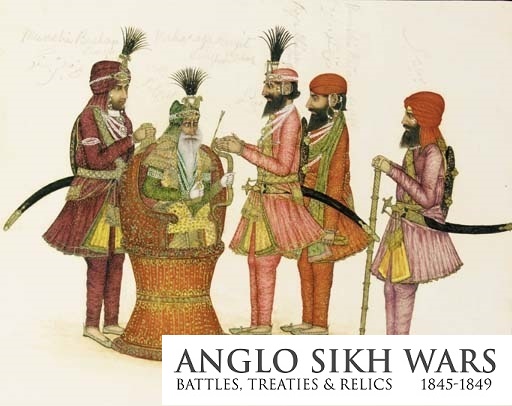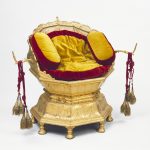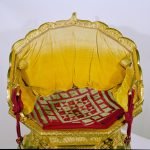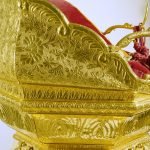The golden throne of Maharaja Ranjit Singh
Place of origin:Lahore, Pakistan (made)
Date:1820-1830 (made)
Artist/Maker:Hafiz Muhammad (maker)
Materials and Techniques:Wood and resin core, covered with sheets of repoussé, chased and engraved gold
Museum number: 2518(IS) Copyright: © Victoria and Albert Museum, London 2016
Golden octagonal throne, of waisted shape, with 8 feet and handles at narrowest part. The throne has a raised, solid back, with supports on the left and right side, from which tassles hang. The seat contains gold and red cushions and overall the gold is embossed with abstract designs.
1818 was the year when Multan finally fell to the Sikhs, and it is likely that the throne was commissioned to mark the event. The throne is traditionally associated with Lahore, where it was found in 1849 after the British annexed the Punjab and took over the royal treasury. The Governor-General, Lord Dalhousie, was not sure if the throne would be wanted in Britain, writing to London ‘It is set apart as an object which the court [of the East India Company] would probably desire to preserve, but as it is bulky, I shall not forward it until I receive orders to do so’. The Company did wish to preserve it, and in 1853 the throne travelled to Calcutta (where Dalhousie had a wooden replica made) before it was shipped to the Indian Museum in London. In 1879, Ranjit Singh’s Golden Throne moved to the South Kensington Museum, later renamed the Victoria and Albert Museum., where it has remained ever since.
Maharaja Ranjit Singh has also been depicted in other chairs including in a basket chair, with Munshi Bishan Singh, Raja Dhian Singh and Munshi Ratan Singh. The following painting sold at auction in 2001 at Christies Auction House.

Further information
Stronge, Susan. The Arts of the Sikh Kingdoms. London: V&A publication, 1999. p82, fig 90.
Gurinder Singh Mann, SMI Lecture, ‘Sikh Relics in the UK’, Punjabi University Patiala-April 2015



